Anne
and I would begin our walking tour of Singapore by visiting Singapore's
Chinatown. It seems strange that a city whose population is over 70%
Chinese would have a district called Chinatown. This dates to the
early British settlement when the Chinese immigrants were a minority.
Raffles, to keep racial tensions minimized, divided the city into
districts based on ethnic groups. Chinatown was allotted the area
south of the Singapore River. Three years after Singapore was settled
Chinatown had 3,000 inhabitants, most of them penniless and half starving
immigrants from mainland China. Over the next decade their numbers
would grow to exceed 30,000. The living conditions must have been
horrid. Chinatown was a relatively small area for such numbers of
people. Slophouses, two-story buildings with shops or small factories
on the ground floor and living quarters upstairs, were common. Often
twenty to thirty lived in a single room. The British did not provide
police protection in Chinatown. This was the responsibility of the
Chinese guilds, or clan associations, to oversee their own law and
order.
Until recent times Singapore's Chinatown was slated for demolition.
However the government, recognizing the people's desires and the historical
importance of the area, canceled plans to raze Chinatown and are now
in the midst of reconstruction. |
|
|
|
|
|
|
|
|
|
|
|
|
|
|
|
|
|
|
|
| The
best way to see and enjoy Singapore's Chinatown is to walk its streets,
but first we had to get from the hotel to Chinatown. Taxi's are readily
available as are buses, but the best way to travel throughout Singapore
is by using its subway system, the MRT. |
|
|
|
|
|
|
|
|
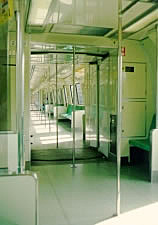 Singapore's MRT
Singapore's MRT |
|
|
|
|
|
|
|
|
|
|
|
|
|
|
|
|
Singapore's
MRT was wonderful. Being a seasoned subway traveler forced to take
subways in New York City from time to time I appreciated Singapore's
subways. As you can see by the photo at right the cars were spotless.
Not a single piece of newspaper laying anywhere about. Underground
stations were all air-conditioned and the fares were inexpensive.
New York could certainly learn something from Singapore about subway
service and cleanliness. |
|
|
|
|
|
|
|
|
|
|
|
|
|
|
|
|
|
|
|
|
|
|
|
|
|
|
|
|
|
|
|
|
|
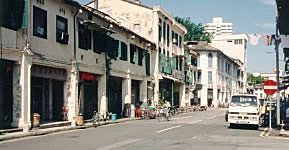 Two-story
Slophouses
Two-story
Slophouses
of Chinatown |
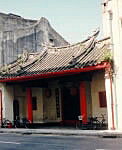 Fuk
Tak Chi
Fuk
Tak Chi
Taoist Temple |
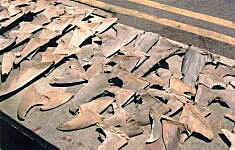 Dried
Shark Fins for sale
Dried
Shark Fins for sale
on the sidewalk |
|
Street
scenes from Singapore's Chinatown District
|
| Chinatown,
in the early 1800's, was the site of many brothels and opium dens.
The building (right) with its bright red awnings and portico is said
to have been a famous brothel during Singapore's colonial period.
Brothels and opium dens were common throughout Chinatown and were
important. Those that frequented them were Chinese immigrants who
came to Singapore alone and worked long hours with little time for
rest and relaxation. The brothels and opium dens provided them some
diversion from these horrible conditions. |
|
|
|
|
|
|
|
|
|
|
|
|
|
|
|
|
|
|
|
|
|
|
|
The
Wak Hai Cheng Bio Temple was very interesting. First it dramatically
showed the coexistence between the old and the new with modern buildings
located immediately behind it. Second, the roof ornaments were elaborately
carved and painted. Built between 1852 and 1855 by the Teochew Chinese
the temple is dedicated to the goddess of the sea. Inside the temple
were altars where the faithful, who had purchased paper models of
the necessities of life (money, cars, airplanes, horses, boats, etc.)
could ritually burn them as offerings to departed loved ones. It is
believed that their essence, represented by the flames and smoke,
passed through to the spirit world for their loved ones to enjoy.
|
|
|
|
|
|
|
|
|
|
|
|
|
|
|
|
|
|
|
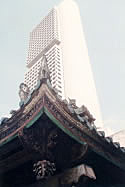 |
|
|
|
|
|
|
|
|
|
|
|
|
|
|
|
|
|
|
|
| The
roof of the Wak Hai Cheng Bio Temple was beautifully and elaborately
carved with various serpent and human figures. We would learn that
this was common throughout Singapore and not only to the Chinese temples
in Chinatown. Many of the temples had wonderfully elaborate decorations
on their roofs as well. |
|
|
|
|
|
|
|
|
|
|
|
|
|
|
|
|
|
|
|
|
The
Thian Hock Keng Temple, "Temple of Heavenly Happiness,"
was completed in 1841 is one of Singapore's oldest and largest
temples. Before Singapore's land reclamation project the temple stood
on the shore at the point where the Chinese immigrants first stepped
on land after crossing the perilous South China Sea. The temple is
dedicated to "Ma Chu Poh," the goddess of the sea.
Thian Hock Keng Temple is elaborately decorated with gilded carvings
and sculptures. The main temple is Taoist, but a smaller temple in
the rear is Buddhist and dedicated to Kuan Yin, the goddess of mercy. |
|
|
|
|
|
|
|
|
|
|
|
|
|
|
|
|
|
|
|
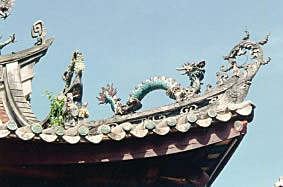 Roof
of the Thian Hock Keng Temple
Roof
of the Thian Hock Keng Temple |
 Worshiper
praying at Thian Hock Keng Temple
Worshiper
praying at Thian Hock Keng Temple |
|
|
|
|
|
|
|
|
|
|
|
|
|
|
|
|
|
|
|
|
| Continuing
our walk through Singapore's Chinatown we came upon the Sri Mariammam
Temple, a Hindu temple. Its pagoda-like entrance is topped by
one of the most ornate gopurams (pyramidal gateway towers) in all
of Singapore. Hundreds of brightly painted statues of deities and
mythical animals line the tiers of this towering pyramid. Glazed cement
cows sit seemingly in great contentment atop the surrounding wall. |
|
Pagoda
entrance at
Sri Mariammam Temple
|
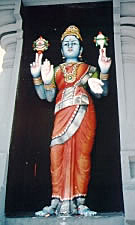 A
deity in the wall at
A
deity in the wall at
Sri Mariammam |
|
|
|
|
|
|
|
|
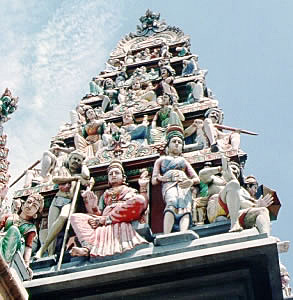 Closer
look at the gopurams of Sri Mariammam's
Closer
look at the gopurams of Sri Mariammam's |
|
|
|
|
|
|
|
|
|
|
|
|
|
| The
roof of the entire temple, including the inner buildings (right),
were all topped by the brightly colored figures. Truly an amazing
sight. |
|
|
|
|
|
|
|
|
|
|
|
|
|
|
|
|
|
|
|
|
|
On
our walk we ran into a Chinese market and enjoyed the sights and smells
of the foods hanging in the open air. In this picture (left) Anne
can be seen looking at an array of dried meats including pressed ducks
(center). Naturally the aroma of the foods in the air made us a bit
hungry and we stopped to enjoy a quick snack.
Leaving Chinatown Anne and I headed toward Merlion Park located not
far away next to Marina Bay. |





